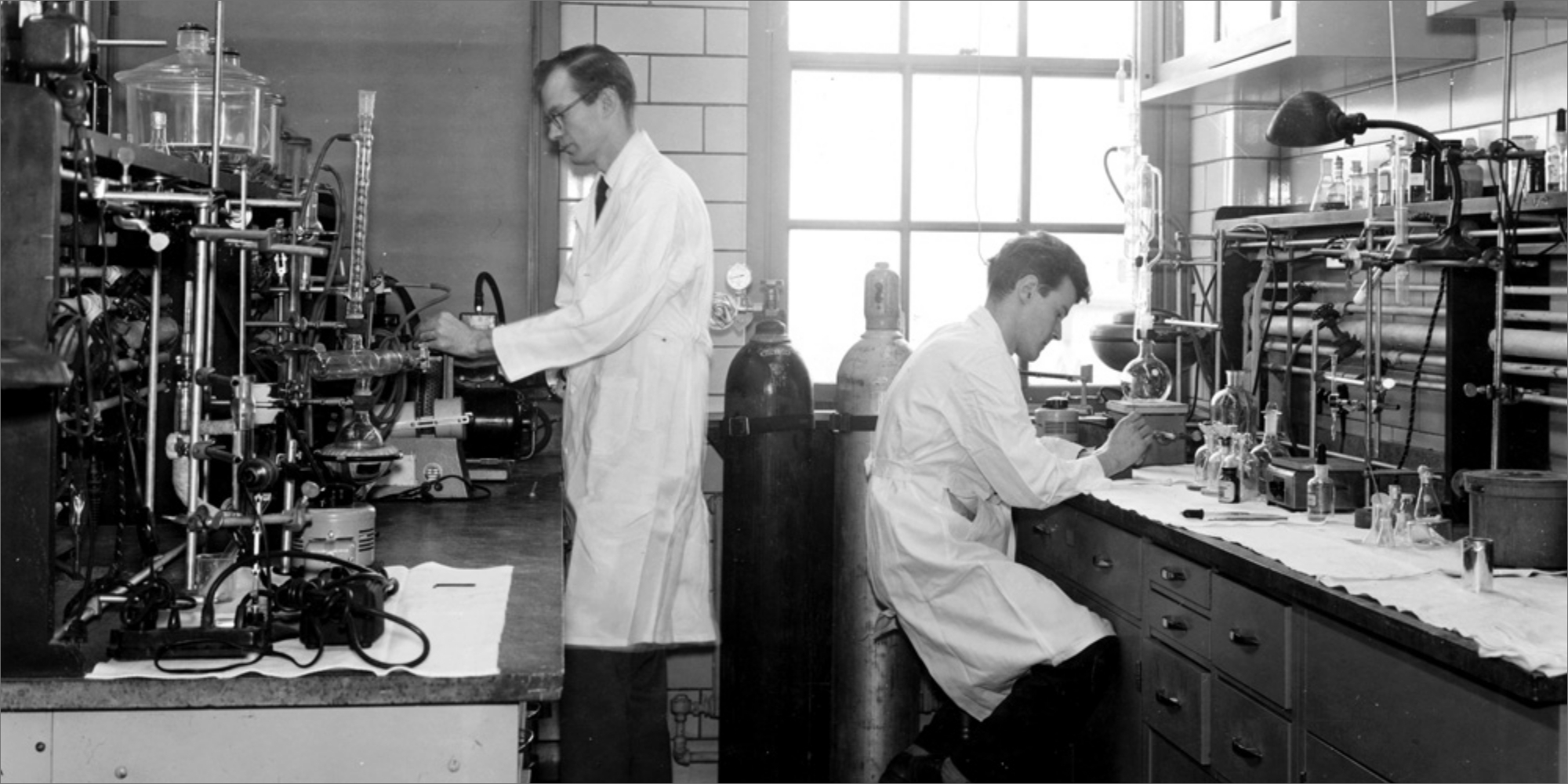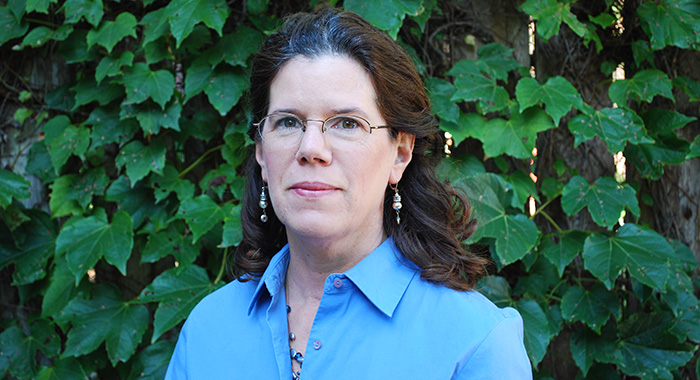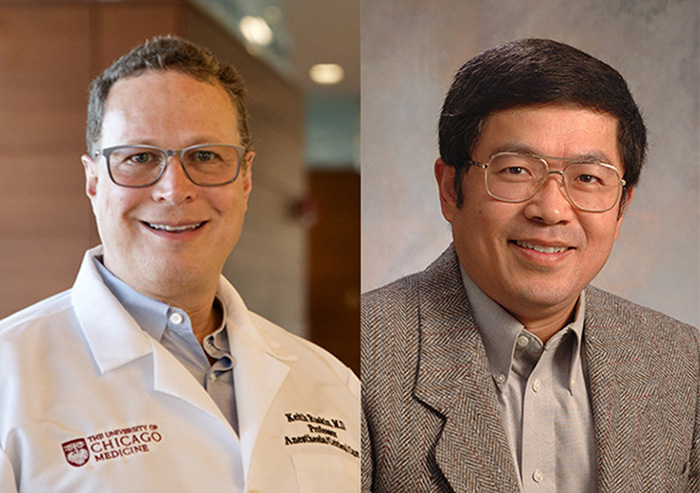
(UChicago Photographic Archive, apf2-00691, Hanna Holborn Gray Special Collections Research Center, University of Chicago Library)
Sit in on two classes that get high marks from students.
Jill Mateo, associate professor in comparative human development, knows what the students in her Darwinian Health course are thinking.
She knows because she assigns reaction papers, due before class. She walks in understanding what the students think of the day’s readings (“You guys hated it,” she says of one 1993 article. “Really interesting.”) and what they’re confused about: “A couple of you pondered the evolution of sex. You still have questions? Why do we have male and female?”
It’s a gray, overcast day late in Winter Quarter. Twelve masked students sit around a long table in Rosenwald Hall, with four more in desks at the edges; Mateo stands at a lectern in the front. Today’s topic is sex and reproduction.
According to the syllabus, Darwinian Health takes “an evolutionary, rather than clinical, approach” to health and disease. So far the course has covered pregnancy sickness, senescence, allergies, cancer, and more. Mateo, who holds appointments in the Committee on Evolutionary Biology and the Institute for Mind and Biology, earned a doctorate in biopsychology; most of her research focuses on Belding’s ground squirrels.
When no one offers much of an answer to the male-female question, Mateo explains. “The default state is asexual, and the default sex is female,” she says. Asexual reproduction has its advantages: “You don’t have to divide your gametes, you’re just reproducing clones. But what if the environment changes?” That’s when sexual reproduction—or “mixing up gametes,” as Mateo describes it—might help your species survive. Maybe at least one of the offspring will be suited to the changed environment.
“We don’t have the Wayback Machine to see how we ended up with sperm and eggs,” Mateo continues. But at some point in evolutionary history, something in the environment of evolutionary adaptedness (during class, this is just referred to as “the EEA”) resulted in anisogamy, meaning unequal gamete size. “This unequal investment in gametes sets the stage, in the world of sexual selection, for a lot of sex differences,” Mateo says. Males, who invest very little in their gametes, tend to invest less in their offspring, while it’s the opposite for females, she says. Females are also much choosier about partners.
Mateo brings up a slide with the headline, “So, do humans fit predictions of mate choice?” above two black-and-white photographs: on the left, some 19th-century guy in a dapper three-piece suit; on the right, Marilyn Monroe. “Anybody know who this is?” she asks, then clarifies, “The male.” The class laughs. Everyone recognizes Marilyn Monroe.
“John D. Rockefeller,” she says, “the richest man in the world. He founded Standard Oil and the University of Chicago. Rockefeller Chapel?” Sounds of “ohhh” and more laughter.

Since Rockefeller had so many “resources” (in the parlance of evolutionary biology) “he would be expected to be desired,” Mateo says. Meanwhile Marilyn Monroe “shows signs of fertility: glossy hair, taut skin. Those are signs that men might find attractive.”
Mateo flips to a slide about reproductive potential for men and women. “What do you think the record is for the most offspring that a woman bore?” Students call out answers ranging from the high teens to the low twenties.
Mateo reveals the number—69—to a lot of surprised noises. “I honestly feel bad for whoever that woman was,” one student murmurs. (The first wife of 18th-century Russian peasant Feodor Vassilyev, whose name has been lost to history.)
“She had lots of twins and triplets,” Mateo says, explaining the seemingly impossible math. “But most of them survived.”
And for men? Now the students’ guesses are much higher. The actual total: 888, the children of 18th-century Moroccan ruler Moulay Ismail Ibn Sharif.
Those two hold the records for lifetime reproductive success. A “more realistic” limit for lifetime reproduction for a human female—since most women do not have multiple sets of twins or triplets—is 12 to 20 children. How about for a human male?
“It could be, like, infinite,” one student offers. Another student agrees. Mateo reveals the answer on the slide: “???”
“Across all species, is polyandry [when females have more than one male partner] less common than polygyny?” a student wants to know.
“That’s a great question,” says Mateo. “Polyandry is fairly rare. We see it in some bird species, very few mammals, some insects, but it is rare.” In such polyandrous situations—among pipefish, for example—males are the choosy ones.
According to evolutionary theory, there’s always a logical explanation for choosing a mate based on what might—among humans—be considered shallow reasons. Male pipefish prefer long females to short females: “Female length is an indicator of her quality and the number of eggs she might be carrying,” Mateo explains. Male pipefish also prefer female pipefish with a large skinfold, “which again might signal something about her genetic quality.”

After the slide presentation, Mateo leads a discussion on each of the day’s three readings in turn. The first, an article titled “Pathogen Prevalence and Human Mate Preferences,” found that in areas of the world where certain diseases are more common, physical attractiveness is more important in mate choice than in other parts of the world. (Put simply, physical attractiveness serves as a proxy for health.) A second paper, “Chemical Signals and Parasite-Mediated Sexual Selection” shows that female mice, who are attracted to male mice’s urine scent marks, prefer healthy mice to those infected with a parasite.
In a discussion about the risks and costs of reproduction, a student asks, Are conditions ever so harsh that sperm production stops entirely?
“That’s a really good question that I don’t think anyone has posed before,” Mateo says thoughtfully. “I suspect if males are in really poor condition, at some point testosterone production is going to decrease,” which eventually could inhibit sperm production.
“Google says after 16 days of starvation,” another student volunteers. (Clicking through to the source reveals a 1969 paper by two professors in Clemson University’s poultry science department. Seemingly this research has not been widely done on other species.)
With 12 minutes left, Mateo turns to the final reading, “Human Longevity at the Cost of Reproductive Success.” The authors looked at centuries of birth and death records for British aristocratic families, some dating back to 740 CE.
“Why do you think they chose to limit their study to British aristocracy?” Mateo asks.
“They’re reasonably homogeneous,” a student points out.
“Right. It’s a really good sample. The data are rich,” Mateo says, adding, “Pun not intended.”
The paper draws a correlation between a woman’s age when her first child was born and her age of death. The paper fits with “disposable soma theory,” Mateo explains: “You can invest in your body, or you can invest in reproduction. Investment in total is limited.”
“The later a woman had her first pregnancy or childbirth, the longer she lived,” as one student put it. “And I was like, that’s a take.” Once again, the class is laughing.

“Welcome to BIOS 24217, The Conquest of Pain!” reads the first sentence of Keith Ruskin’s syllabus. Ruskin, professor of anesthesia and critical care, has published research on such topics as the safe use of automated medical technology, personal protective equipment and human performance, and supplemental oxygen for rescuers doing chest compression (it may increase the amount of time rescuers can sustain their efforts).
Among the notable characteristics of the popular biology/neuroscience course: the long list of guest lecturers, the chance to shadow Ruskin during actual surgeries, and his extreme enthusiasm.
As today’s guest lecturer, Ming Xu, sets up at the front of O-413, the anesthesia conference room, a student tells the class about her shadowing experience. She observed two cases. In one procedure, a patient had a mass removed from his knee. Watching the man suddenly regain consciousness afterward “was really cool,” she said. “It was just like that.”
A more complicated procedure, a patient with a tumor in his neck, went on much longer, so she didn’t observe it all. The surgery, “a very big neck dissection and reconstruction,” as Ruskin describes it, began at 8:00 a.m. and wrapped up around 1:30 a.m.
“Does the surgeon rotate out?” another student wants to know.
In this case, Ruskin explains, a few teams were required: ENT (ear, nose, and throat) surgeons as well as plastic surgeons. “They will take periodic rest breaks and bathroom breaks,” he says. Sometimes there are quiet moments when those who aren’t directly involved can step away.
At other times, “it’s all-hands-on-deck,” Ruskin says. For most of the students in the class, “I’ve been able to leave the room with you and show you around. But a couple of you had experiences where it was like, ‘I’m really sorry. I can’t leave here right now. You’re just going to have to watch me deal with this problem.’”
Another student asks about the type of anesthesia used for lengthy procedures. Is it safe for a patient to be under for so long?
“How many more weeks do you have for the answer?” Ruskin quips. The quick version is yes and no. “After an 18- or 20-hour procedure, it might not be safe to allow the patient to wake up right after,” due to fluid shifts, swelling, or other factors, he says. “Usually you let them stay asleep overnight.” Some drugs tend to accumulate in the body over time, but in the case of a long procedure, that can be an advantage: it helps keep the patient asleep until morning.
So far this quarter, the course has featured 10 guest speakers, lecturing on subjects such as chronic pain and spinal, regional, and general anesthetics. “Do Children Feel Pain?” was the title of one lecture. “A Psychologist Looks at Pain” was another.
Ruskin introduces Xu, a professor of anesthesia and critical care, whose topic is drug addiction, as well as a novel treatment he helped develop that “I am confident will revolutionize” how addiction is treated, Ruskin says.
Wearing a gray V-neck sweater, beige pants, and comfortable shoes, Xu is soft-spoken with a calm demeanor. “There is a huge unmet need for proper treatment,” he says. “It’s one of the most active areas in biomedical research.” Pain relievers—as anyone who follows the news knows—are a common source of drug misuse. “And I’ll have plenty of slides to show that,” he adds, somewhat ominously.
First, Xu defines the different risks of drug use (which is occasional and recreational, with the primary concern being acute overdose), drug misuse (more frequent; characterized by a negative effect on the user’s life), and drug addiction. Addiction “is not just a bad habit or lack of willpower,” he says. It’s a chronic brain disease, characterized by compulsive drug seeking and taking—and it’s very difficult to extinguish.

Xu’s slides, with clear yellow and white text against a peaceful blue background, belie their dismaying content. He walks the class through the most commonly abused categories of drugs. Opiates and opioids (opiates are derived from the opium poppy, while opioids are synthetic). Alcohol. Nicotine. Psychomotor stimulants (cocaine, amphetamine, methamphetamine). Cannabinoids. And finally club drugs (LSD, MDMA, GHB).
Some of these drugs, Xu notes, have medical and other uses. Amphetamine is used by fighter pilots, for example, to increase focus and energy.
“There are two drugs that are used in the military as ‘go’ pills,” Ruskin interjects: amphetamine and, increasingly, modafinil. (Ruskin, a fellow of both the Aerospace Medical Association and the Royal Aeronautical Society, is an expert on aerospace medicine.)
Each squadron of pilots has a flight surgeon who issues pills “to take under extenuating circumstances only,” he explains. But first, pilots are required to take them while on the ground to judge the effects, because the drugs can cause aggression. “The last thing you want is an aggressive, emotional fighter pilot.”
Back to Xu, who adds two more categories of drugs to the frequently abused list—prescription medications and anabolic steroids—before warning, “The next five slides have really discouraging data.” Opiates and opioids (the terms are often used interchangeably) account for 70 percent of global drug addiction, he says. But alcohol, smoking, and psychostimulants are also serious problems. Xu takes a dim view of marijuana use despite its changing legal status: “It’s particularly bad for infants, children, and teenagers, because the brain is still developing.”
Different classes of drugs target different brain receptors, Xu continues, and many are related to elevated dopamine release. In animal models, for example, cocaine is more addictive than natural rewards, such as food or sex. “Cocaine wins all the time,” he says.
A student has a question: Could these drugs be used to treat diseases with low levels of dopamine, such as Parkinson’s?
“Your thought is right,” Xu says. But attempts to control dopamine—which could also alleviate schizophrenia, characterized by excess dopamine—have not been successful. “There’s a lot of research, but no optimum outcome.”
Having described the scope of the problem, Xu introduces his own research: “I’m kind of proud of this,” he says, “because it addresses a huge unmet need.”
His experimental treatment, as bizarre as it might seem, is to remove a piece of skin, culture the cells, edit the genome slightly, and graft the skin back onto the donor (mice, in this case). The genetically modified skin cells release a molecule that regulates dopamine, dulling alcohol cravings. Another type of modified cells can make an enzyme that breaks down cocaine. Why skin? For two practical reasons: it’s easy to access, and skin cells can withstand a long culture time in the lab.
Xu’s research is so new, he had launched a start-up, AddGraft Therapeutics, just two months before his Conquest of Pain lecture. Soon afterward the story hit the mainstream media, with articles in the Chicago Tribune and the New York Post.
The treatment is effective on cocaine addiction, alcohol addiction, and both together—but not methamphetamine. “It works really nicely,” Xu says. “We’re looking forward to translating it to human testing.”
Presentation over, Xu asks if students have any questions. There are hands up all over the room.
